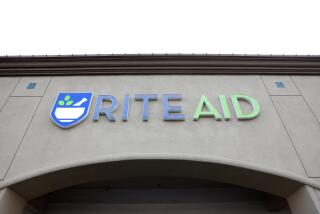AIG plans to sell assets to pay debt
- Share via
CHARLOTTE, N.C. — The insurer American International Group Inc. said Friday it plans to sell a number of business units to pay off its massive government loan.
The announcement was expected by Wall Street. But it now leaves investors wondering how much AIG will be able to raise from the sales.
On the brink of failure last month, AIG was bailed out when the government offered it an $85-billion loan during the ongoing credit crisis that saw Lehman Brothers Holdings Inc. file for bankruptcy protection and the sale of Merrill Lynch & Co. to Bank of America Corp.
In return for the loan, the government received warrants to purchase up to 79.9% of AIG.
Shortly after the deal, Edward Liddy, AIG’s newly appointed chairman and chief executive, said he planned to quickly raise funds through asset sales, but hoped to hold on to as many of the company’s insurance operations as possible.
AIG, one of the world’s biggest insurers, didn’t specifically disclose all the assets it would sell or the expected prices from the sales.
But the New York-based insurer said it plans to retain its U.S. property and casualty and foreign general insurance businesses, and also plans to retain an ownership interest in its foreign life insurance operations.
Liddy, former chief executive of Allstate Corp., said AIG has been contacted by “numerous” parties regarding possible sales of businesses, and AIG will try to sell its operations to “brand-name” buyers who have strong ratings and balance sheets.
Even though the company didn’t disclose many specifics, Liddy did say he was hopeful that the two-year, $85-billion government loan would be enough to provide AIG “the flexibility we need to work our way out of this situation.”
“Our goal is to emerge from this process in a timely fashion as a smaller, but more nimble company that is solidly profitable and has attractive, long-term growth prospects,” Liddy said in his first call with investors and analysts.
“I think what the Federal Reserve has provided us has been very generous and we are going to do everything we can not to have to go back to them.”
Problems at AIG did not come from its traditional insurance subsidiaries, but instead from its financial services operations, and primarily its insurance of mortgage-backed securities and other risky debt against default.
If AIG couldn’t make good on its promise to pay back soured debt, investors feared the consequences would pose a threat to the U.S. financial system, which led to the government bailout.
AIG’s traditional insurance subsidiaries have widely been viewed as safe.
As of Sept. 30, AIG had drawn $61 billion on the credit facility, of which about $54 billion has gone toward securities lending and its financial products area. The rest of the money has been for other liquidity needs amid an “unprecedented” freezing of credit markets, Liddy said.
AIG shares fell 14 cents, or 3.5%, to $3.86.
More to Read
Inside the business of entertainment
The Wide Shot brings you news, analysis and insights on everything from streaming wars to production — and what it all means for the future.
You may occasionally receive promotional content from the Los Angeles Times.










